
I arrive still jet-lagged after a 13-hour flight from Basel. My head is spinning and I’m disoriented. It’s November 2019, and I’m here at The Faculty of Architecture, Design, and Urbanism (FADU), at La Ciudad Universitaria, the University of Buenos Aires campus, to participate in La Entrega Final—the final project delivery and feedback session at the Chair of Design and Gender Studies (DyEG), an eclectic evening that transgresses disciplinary boundaries and brings feminist activism to the center of the classroom.
“La Ciudad Universitaria, para mi, es otro mundo,” (“The University City is, for me, another world”) says Gabriella Giugiotella, one of nine teachers at the DyEG. There is a supermarket, a bank, and even a free day-care service provider for children of the students and employees. It feels like a city within a city, entirely disconnected from the urban fabric, sitting in isolation between a large highway and the Río de la Plata. In the 1950s, the University of Buenos Aires created a new campus to serve the needs of growing faculties of sciences, philosophy, economics, and architecture. Over the course of the 1960s and 1970s, several buildings were constructed, including the FADU’s “Pavilion Three.” The rectilinear building—celebrating glass and concrete, and lacking any ornamentation or color—imposes its presence, and seems to be its own organism.
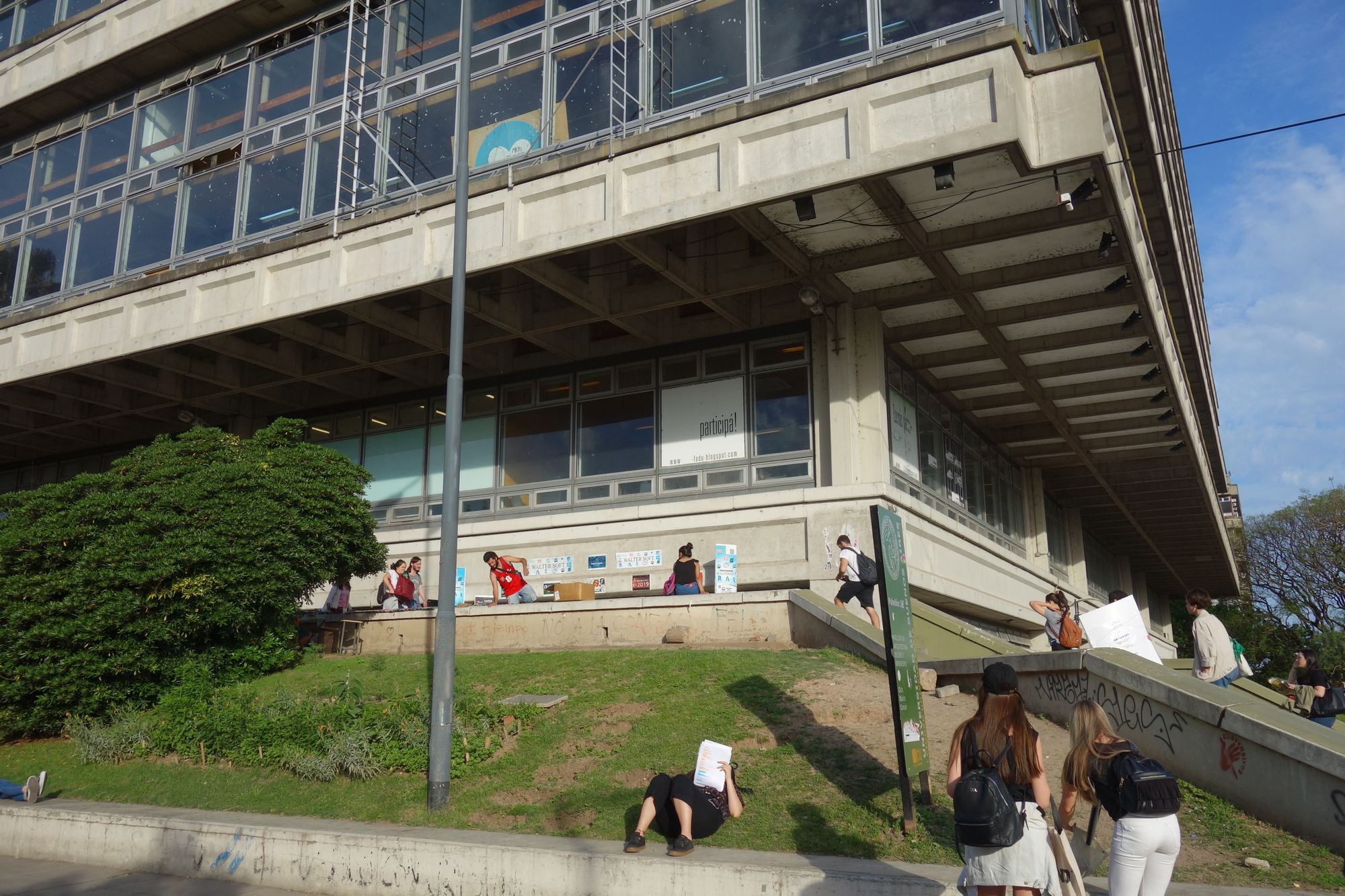
Large fluorescent graffiti next to the main entrance of the FADU catches my attention: “Feminismo es revolución, En la FADU no nos callamos más” (“Feminism is revolution, At the FADU we are not silent anymore”). Fluid strokes of white and black handwriting on the “abortion green” background—a color linked to the National Campaign for the Right of Legal, Safe, and Free Abortion—announce how the political activism of #niunamenos and #quesealey is present on campus. I climb the stairs and pass an “informal” market, with stalls selling everything from plants, hand-made jewelry, books, and clothes to pañuelos verdes, the green scarves that serve as the National Campaign’s primary symbol. In the short time that has passed since I arrived, I have already seen these green triangular scarves on the streets of Buenos Aires—tied to necks or wrists, hanging in backpacks and purses, always popping out and marking their presence.
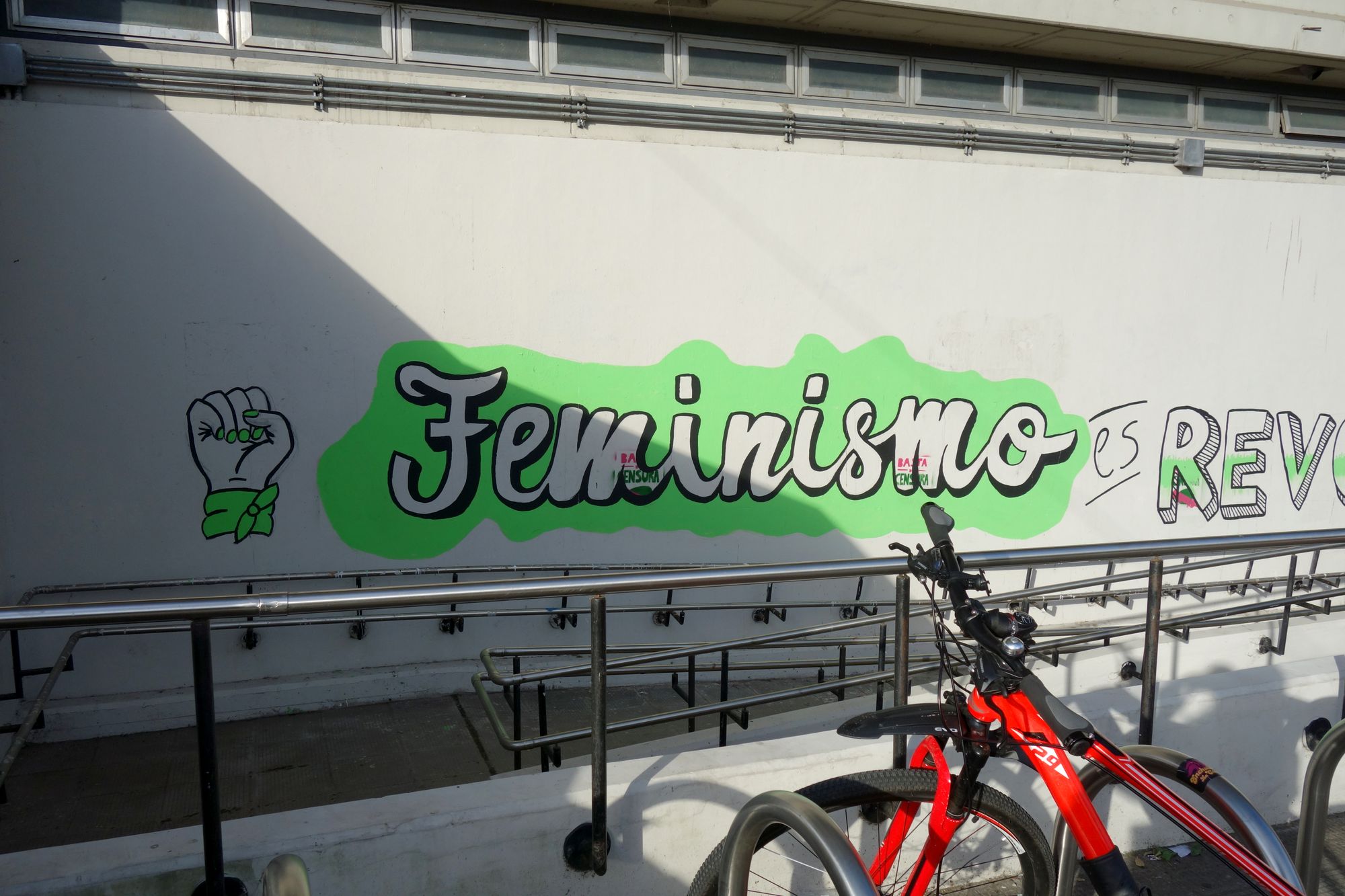
I enter the main hall, trying to get a grasp of the space. The intense November sun pierces through the skylights, illuminating a large panel with over a hundred black and white photographs of Desaparecidos, “the disappeared.” “The FADU was strongly hit by the dictatorship. It was also a very different faculty than it is now,” says Valeria Durán, a sociologist and lecturer at the DyEG. Before the military seized power, there was a strong connection between student movements and working-class struggles. For instance, in 1969 the Faculty of Architecture participated in the International Congress of Architecture, focusing on social housing, and students and teachers co-led courses together. For Durán, they understood academic thought to be inherently political. After the Coup d’Etat in 1976, the regime sympathizer Hector Corbacho became the dean at the FADU, silencing what was then a politically boiling faculty. Around 100 students and members of the faculty “disappeared”—meaning they were brutally assassinated by the regime. The teaching shifted from a socially oriented design towards a technocratic one. Subjects such as sociology or psychology were removed from the curriculum, which set its new focus on fulfilling the needs of a free market and supposedly “apolitical” aims. Even to this day, there is a dissonance between the political militancy of the students and a lack of political engagement within the curriculum. As Valeria Durán explains, the faculty seems to be a place where “politics seems like it’s out of this world. I feel that in the majority of the courses, politics is simply out of the classroom.”
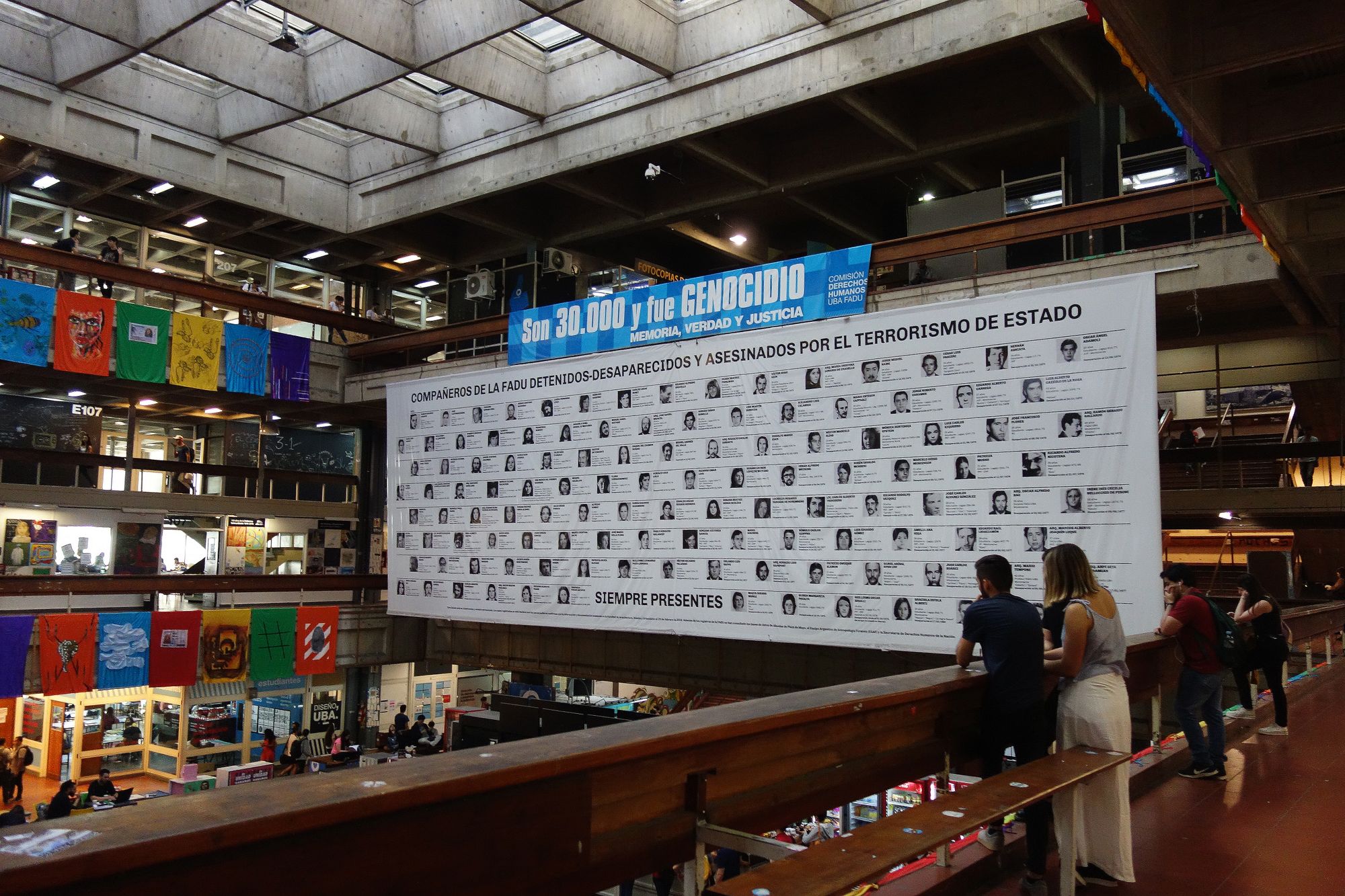
This lack of politics is something that students feel acutely, and the reason that many of them chose the DyEG course, the first elective course on the undergraduate level at the FADU that discusses design practice through queer and feminist theory. One Graphic Design student mentions: “I find it important now, in Argentina in 2019 with all the social movements—#niunamenos, #quesealey, and others—to include a gender perspective in my design. That’s why I enrolled.” The student considers his classes “apolitical,” focusing instead on acquiring theoretical and conceptual tools, and he enrolled hoping to better understand what is happening now in the country.
After wandering through the building, I finally arrive at the workshop room on the third floor to join the DyEG team for La Entrega Final. The noise of the students strolling through the corridors starts to amplify. It is Friday, almost 7:00 p.m., and the last shift at the FADU is about to begin. The University of Buenos Aires offers classes in three periods: morning, afternoon, and evening. The crowd changes accordingly—in the morning, there are mostly young students from affluent backgrounds; in the afternoon, classes become more socioeconomically diverse, culminating in the evening shift from 7:00–11:00 p.m. Despite the free tuition, design studies are still quite elitist, as one still needs substantial financial means to get supplies and devices necessary to meet the demands of the assignments. Many students come from the middle and upper-middle classes. However, most people attending the evening program work part or even full time, either to support themselves or to guarantee a smoother professional start after graduation. Some come from working-class backgrounds or have to travel from the provinces, and others are also parents and have to provide for their families.
“Decisions about course scheduling are inherently political ones, influencing who is excluded or included, and which bodies are present.”
Decisions about course scheduling are inherently political ones, influencing who is excluded or included, and which bodies are present. For instance, Buenos Aires is a city with the largest Jewish community in Latin America, many of whom study at the FADU, but a class on Friday evening is impossible for observant Jews due to Shabbat celebrations. Also, students living in high-crime areas might be hesitant to participate in a class that ends late in the evening, as their way back home might be dangerous. There is no perfect time that suits everyone.
Soon, La Entrega Final begins. My head is spinning, trying to follow the cohorts of students who are entering the space. The group is predominantly white, which reflects the demographics of Buenos Aires. According to the last census, almost 90% of the inhabitants of the city self-identify as white, 7% as “Mestizo” (mixed), 2.1% as indigenous, and only around 0.6% as of African descent. The reasons for this are deeply rooted in Argentina's history of state-sponsored racial violence. From the beginning of the 20th century, the state and its elites initiated a racist project of “whitening” the population. Violent oppression and massacres of indigenous people, as well as unrestricted mass European immigration, led to establishing the national myth of the so-called Argentina Blanca (White Argentina). This idea still prevails by a substantial portion of the society, who imagine the country as white and European, despite continuous indigenous resistance and activist efforts to scrutinize and challenge this belief. Argentina’s racist legacy is also problematized during the DyEG course, introducing works by postcolonial and decolonial feminists, and applying this lens to the design field.
The course was initiated in 2017 by Griselda Flesler, a graphic designer, researcher, educator and the head of FADU’s Gender Office. It has since been co-run by an interdisciplinary team of educators including professors, lecturers, and teaching assistants; and comprising of seven women, one non-binary and one cis-man. The student group is made up of graphic and industrial designers, architects, sociologists, communication specialists, and artists. In its five years of existence, a total of 1,581 students have attended the course. The class is offered every semester, and enrolls up to 200 students. To me, at first, a class of this size seemed impossible to handle. During my undergraduate studies in industrial design at Holon Institute of Technology, adjacent to Tel Aviv, we had groups of 30 students at maximum.
“Rather than wait for a structural policy change, the teaching team established a cooperative: each month, lecturers put part of their salary into a common pot to finance the work of three teaching assistants.”
At the FADU, however, which has a student body of roughly 25,000 students, this size is completely normal. Natalia Laclau, one of the lecturers, describes how this class size is characteristic of public universities in Argentina. Since the democratization of higher education in 1918, all state-run universities offer mass, tuition-free education on the undergraduate level, including in the subject of design. Broad access to education is stipulated by law as a right, rather than a service; therefore, there are no entrance exams and enrollment is unlimited. The DyEG course is an elective for undergraduates, and when the online enrollment begins each semester, the class fills within minutes. The team frequently receives angry emails and phone calls from students, disappointed they couldn’t get a place on the course. Ultimately, it is the university that regulates how many students can attend this class, as increasing the number of spots would entail a higher budget, and there are insufficient funds for this. As it stands, the University of Buenos Aires also doesn't pay the teaching assistants, expecting that they would work “ad honorem” for free. Rather than wait for a structural policy change, the teaching team established a cooperative: each month, lecturers put part of their salary into a common pot to finance the work of three teaching assistants.
The workshop room is immense, probably around 200 square meters. The students arrive in batches and begin to hang their projects, quickly filling the space. Forty interdisciplinary groups of five students from all of FADU’s departments developed design responses to Paul B. Preciado’s Un departamento en Urano – An Apartment on Uranus. In the book, the Spanish philosopher and self-described “dissident of the gender-sex binary system” reflects on his own gender transitioning against the backdrop of political and cultural transitions in techno-scientific capitalism. Mindful of the differing financial capacities of the students, the only required deliverable is one A3 print. In a matter of minutes, all of the walls, blackboards, and whiteboards in the room are filled with hundreds of sheets. Everything begins to liven up. The colors, patterns, and textures of the drawings, photographs, renderings, and accompanying texts energize the space. The students circulate and examine the projects of their colleagues. Everyone is talking, and the Rioplatense Spanish with its vivid, unique “sho” and “zho” sounds resonate throughout the space. As I am still quite jet-lagged, I can only hear the noise, amplified by the whirring sounds of airplanes departing from the nearby Jorge Newbery Airfield.
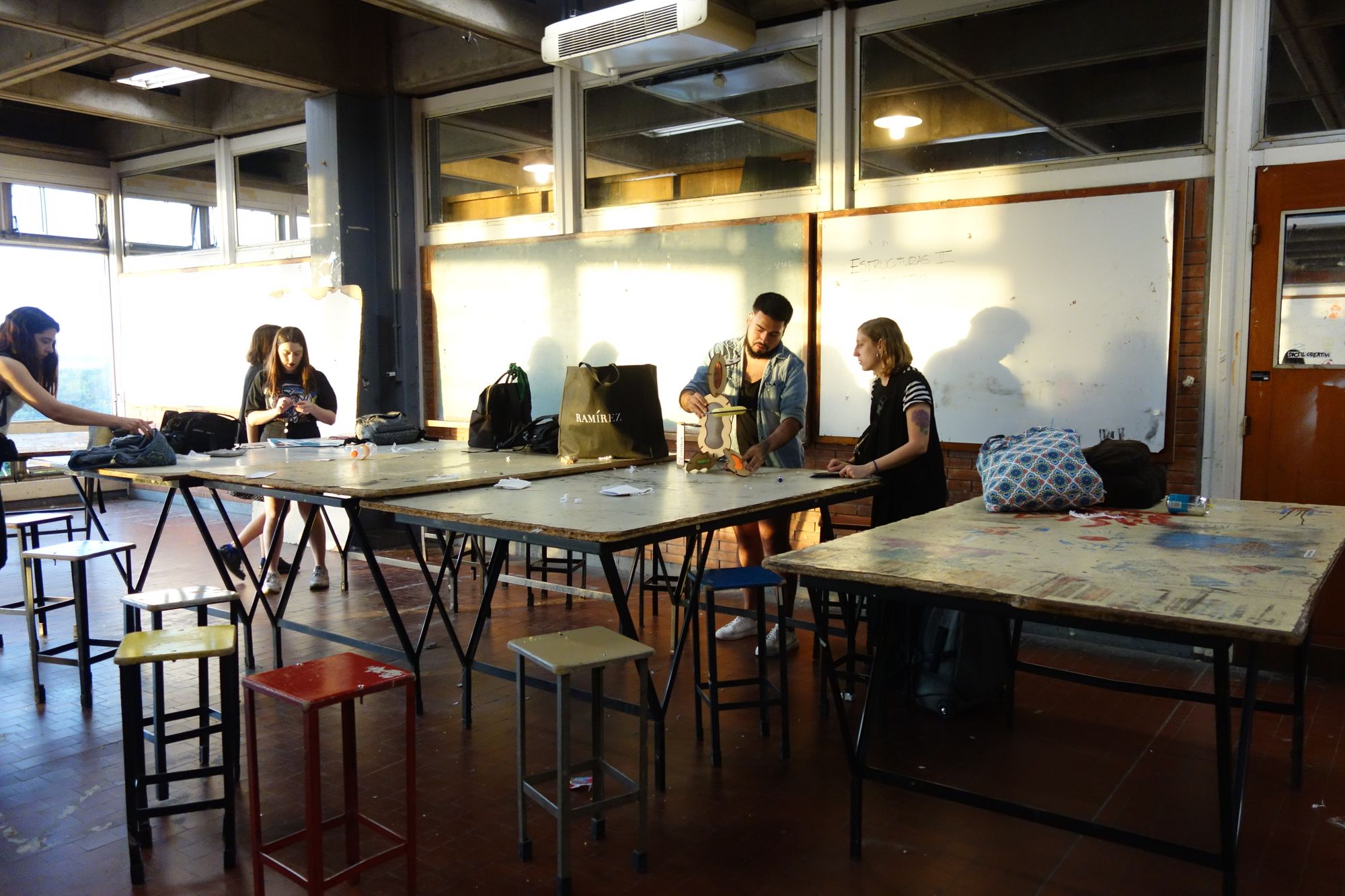
The DyEG course consists of 16 sessions encompassing seven theory lectures followed by nine practical classes. The theoretical part consists of one hour-and-half long seminars by Flesler, Durán, and other invited guests, followed by discussions in four groups of 50 people, together with the rest of the teaching team. The class begins at 7:00 p.m. and ends officially at 11:00 p.m., although often students continue debates later into the night. Topics include: feminisms and the design and architecture canon; introduction to the history of the “Other”; false neutrality; design thinking and the critique of heterosexual normativity; postcolonial design and architecture; technology; and gender studies.
The bibliography for each class includes between three to six obligatory papers or book chapters, as well as around five complementary ones. To assist the process of reading, the teaching team prepares a lecture guide that explains some concepts. The selected literature is translated into Spanish or written by Spanish-speaking authors. “In Argentina, speaking and reading English is still often related to one’s socio-economic background,” Flesler explains, emphasizing the fact that they teach at a public university, and thus have a responsibility to make their pedagogy as widely inclusive and accessible as possible.
The students also underline the importance of the bibliography and critical readings. “Outside of the FADU, I had interiorized feminism,” says Lucia Molina Carpi, a student of Image and Sound Design at the FADU, who grew up participating with her mom in Argentina’s National Womxn Meetings. Held in different cities since 1986, they bring together cis, travesti, lesbian and trans womxn in a democratically chosen venue for three days to participate in workshops, training sessions, and discussions. The meetings are autonomous, democratic, federal, self-managed, and pluralist.
“This course also provokes a certain discomfort. [...] we open ourselves up to questions and issues we had previously naturalized and internalized. Getting out of our comfort zone, we start speaking and designing from other positions.”— Lucia Molina Carpi, student of Image and Sound Design at the FADU
“I would go to the protests for free and legal abortion, and for LGBTQ rights,” Lucia describes. But thanks to Lucia’s participation in the DyEG, she now regularly reads feminist and critical race theory in order to open her mind to new ways of thinking about film that she can apply in her practice. She also notes how she wants to connect her activism with her professional life via the use of moving images. Nowadays, audiovisual media are incredibly potent, opening the door to popular culture and influencing the masses. Lucia wants to have a voice, and for that, she needs tools—to learn how to communicate, and how to develop ideas on a social level. “This course also provokes a certain discomfort,” she explains. “By suddenly departing from the normative mode of thinking that privileges cis, heterosexual, male, white, abled [people], we open ourselves up to questions and issues we had previously naturalized and internalized. Getting out of our comfort zone, we start speaking and designing from other positions—not necessarily only from a woman’s perspective, but from multiple ones.”
Following the theoretical classes, there is a written exam with open questions. The form of a traditional exam enables the teaching team to evaluate the acquired knowledge of Feminist Theory and Gender Studies in a relatively manageable way, even if it takes around three weeks to check the pile of 200 exams. These concepts are fundamental to the subsequent design work. Celeste Moretti, one of the teachers, emphasizes: “We don’t require the students to profoundly know each text, but we do want them to be fluent in the concepts that intersect with their disciplinary fields.”
After the exam, the practical part begins. Students work in interdisciplinary groups of five people followed closely by the teaching team: Celeste Moretti, Gabriela Gugliottella, Natalia Laclau, and Paloma Carignani; assisted by Ismael Menegolla, Florencia Scalise, and Facundo Revuelta. The team divides itself into four “commissions,” each following 10 groups of students during each class, and they have around 20 minutes to discuss each group’s project. Every semester, the students get a different assignment—once, it was a list of national and university laws, another time articles from a newspaper, and now the text by Paul Preciado.
I look around the room, attempting to take in all forty projects hanging on the walls. Though the students do not have to produce prototypes, many do, and their installations fill up the room. A multi-use belt with inclusive patterns, with fluid uses depending on gender identity; a publication on menstrual myths; a board game on constructing identities; an artist’s book; a short documentary about sex life on the campus; a sex toy for the visually impaired; textile room dividers; and more. A text accompanies each visualization, explaining the theoretical framework behind the project. For the teaching team, this part is often more important than the visual result of the project. They are interested in seeing how the theories discussed in the course influence students’ ways of thinking about design and disciplinary divisions.
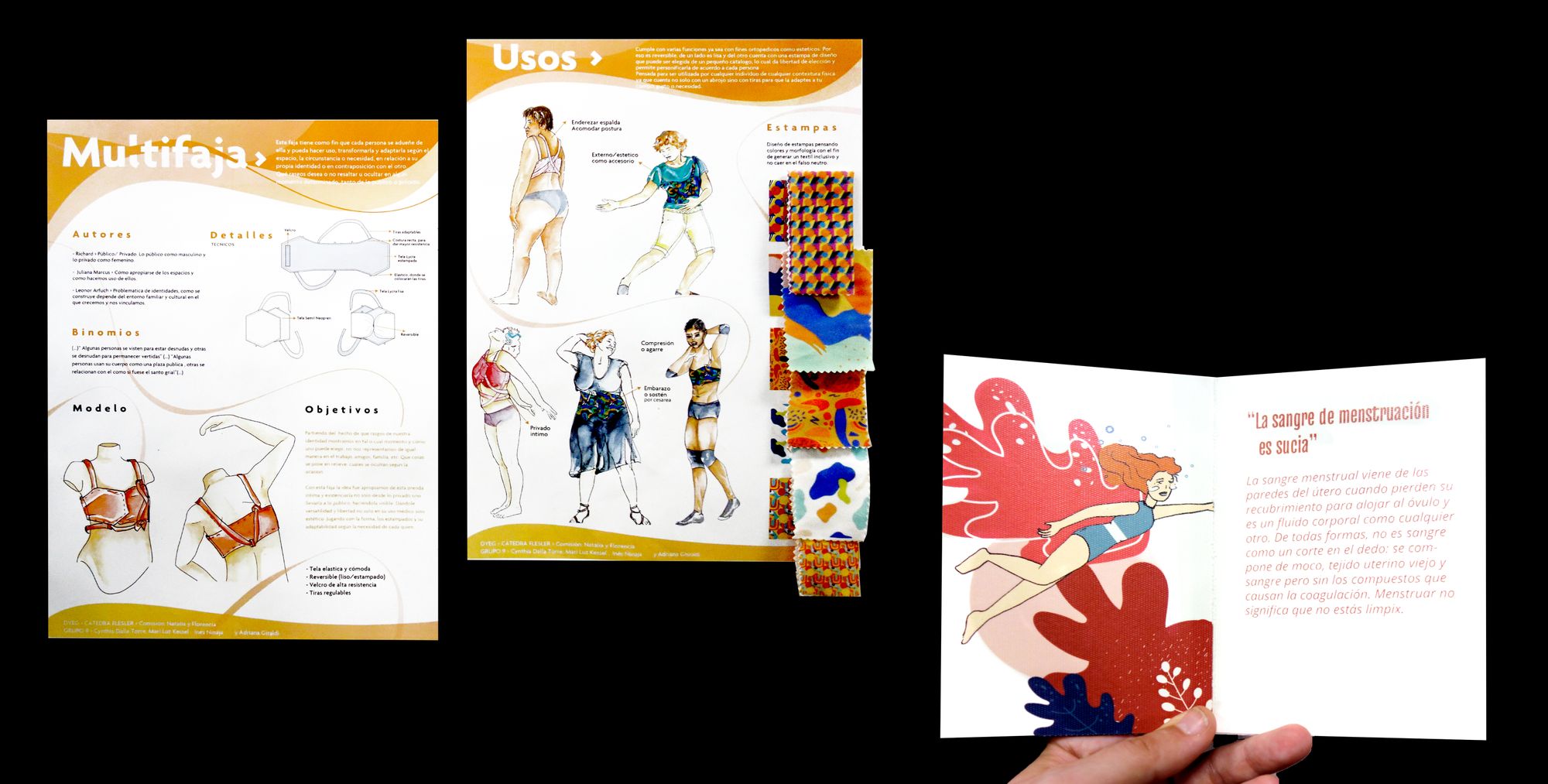
When everything is installed, the students slowly leave the room. The acoustics are horrible, and it would be impossible to discuss their projects with 200 people in the same space. Also, the purpose of La Entrega is different. As a standard format broadly used at the FADU, it is a form of evaluation conducted by the teaching team at the end of each project. Following a semester of discussions and mutual presentations, this time is for the teachers to reflect upon the past four months. A few weeks afterwards, all the students, accompanied by their families and loved ones, will meet again with the teaching team to receive their librito (booklet) with the grades. The team kisses each student and thanks them for participating in the class. This farewell event aims to destabilize the academic hierarchy. By thanking the students, the team wants to acknowledge their contributions to the collective learning process.
Back at La Entrega Final, the group has now whittled down to around 16 people—the teaching team, some interested guests from the National University of Rosario, and me. I can still hear the noise of the students, who wait in the adjacent room. We begin the round. Each teacher presents the projects from their commission individually and talks through the theoretical frameworks, using the texts written by the students. It is already 8:30 p.m., and I’m exhausted, feeling the curtain of jet-lag fogging my brain. I find it difficult to concentrate, especially given that the discussions revolve not around design choices—such as materials, colors, or technologies—but rather juggle between queer theory, Judith Butler’s gender trouble, and Preciado’s ideas of transitioning both gender-wise and politically, and their intersections with design. The intellectual depth overwhelms me, and my head throbs.
“Some people are locked inside their body as if it were Alcatraz. Others only understand freedom as something the body can perform.” This phrase by Paul. B. Preciado was the starting point for the project done by Bernardo Charadía, Carolina Herrera, Carolina Lotti, and Florentina Gajate. Stenciled black type on a white background reads “Hegemogram,” a play of words between “hegemony” and “Instagram.” Below, multiple pictures of magnified parts of the body create a large collage. Sensual lips, upper thighs, hands, eyes, buttocks, breasts, nipples, hair, feet, phalluses—all perfectly carved and conforming to the Western beauty ideal. The thin, young, white, abled bodies, juxtaposed next to each other with thumbs up and heart emojis stuck on them, Beneath this image, the same stencil type says "Tu Libertad es hegemónica” (“Your freedom is hegemonic”).
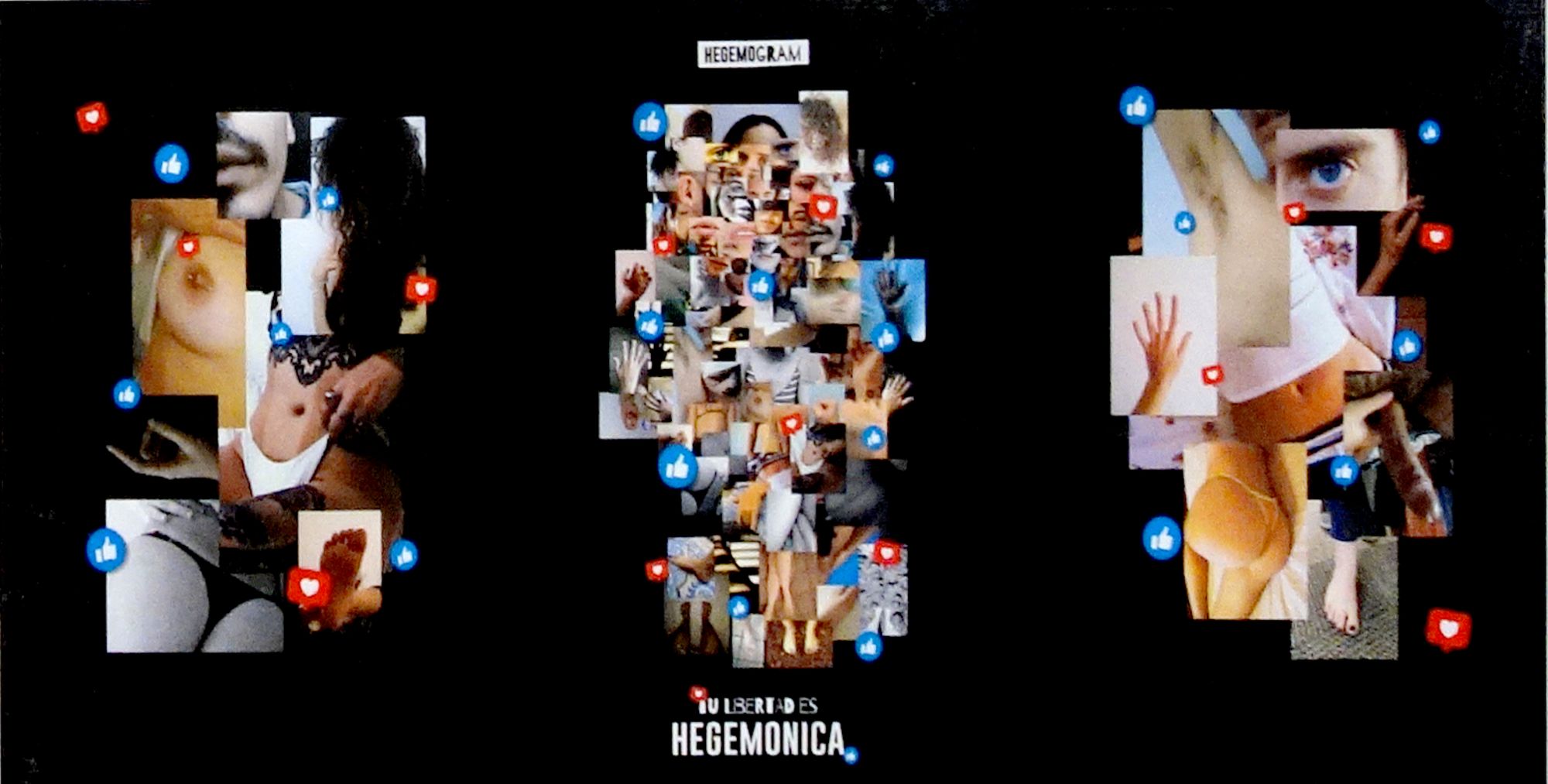
The group’s original idea was something entirely different. They wanted to create a compilation of diverse bodies and design a mural representing bodily diversity and symbolizing freedom. But to collect these references, the students asked their audiences on Instagram and Facebook what was the body part that generated the feeling of freedom, and requested users to send an image of it. When they started receiving the photos, they realized that all the images of parts of the body belonged to skinny people with hegemonic features.
“That’s the universe of their algorithm,” explains Flesler, pointing to how the picture submissions represent the social circle of this particular group: skinny, young, white friends, responding to the dominant perception of a beautiful body. Having noticed their own bias, the group decided to rethink the project and called it “Hegemonic Freedoms.” The title refers to the part of the body that gives you the most freedom and is most related to the hegemonic body. In the end, the students made a video with photos and audio of the people telling them why that part of their body generated the feeling of freedom.
After several hours of vivid discussions about the students’ projects, the work is not yet done. The teaching team picks up all the projects from the walls, puts the printed sheets in a pile, and divides them for further evaluation. It will take a few weeks for them to review everything, and for the students to receive their grades. In the meanwhile, we have to leave the building, as the guards lock it down around midnight.
“There is something about this course that makes you very attentive to the design process, as you are reconfiguring and thinking anew,” summarizes Griselda. “Many things can happen that you only realize at the moment of designing.”
Maya Ober (she/her) is Basel-based activist, educator, designer, and researcher, working across different mediation formats. She runs depatriarchise design, a non-profit design research platform. Maya works as a research associate and lecturer at the Academy of Art and Design in Basel and researches intersectional feminist pedagogies of design.

















